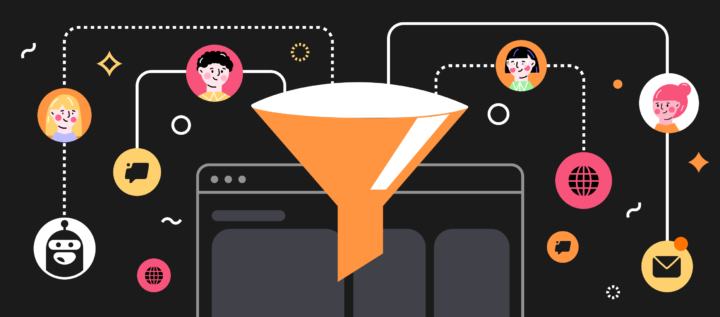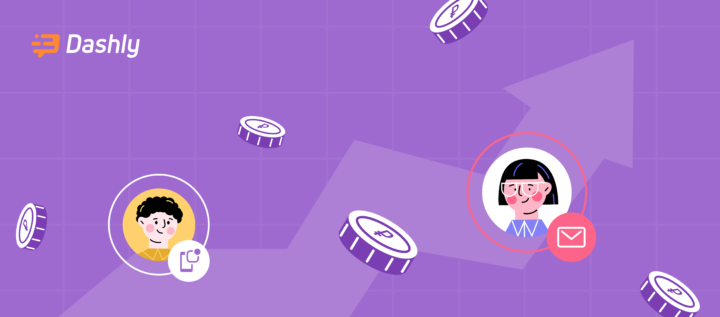An Ultimate Guide To What Is A Sales Funnel? Stages, Tools, Tactics
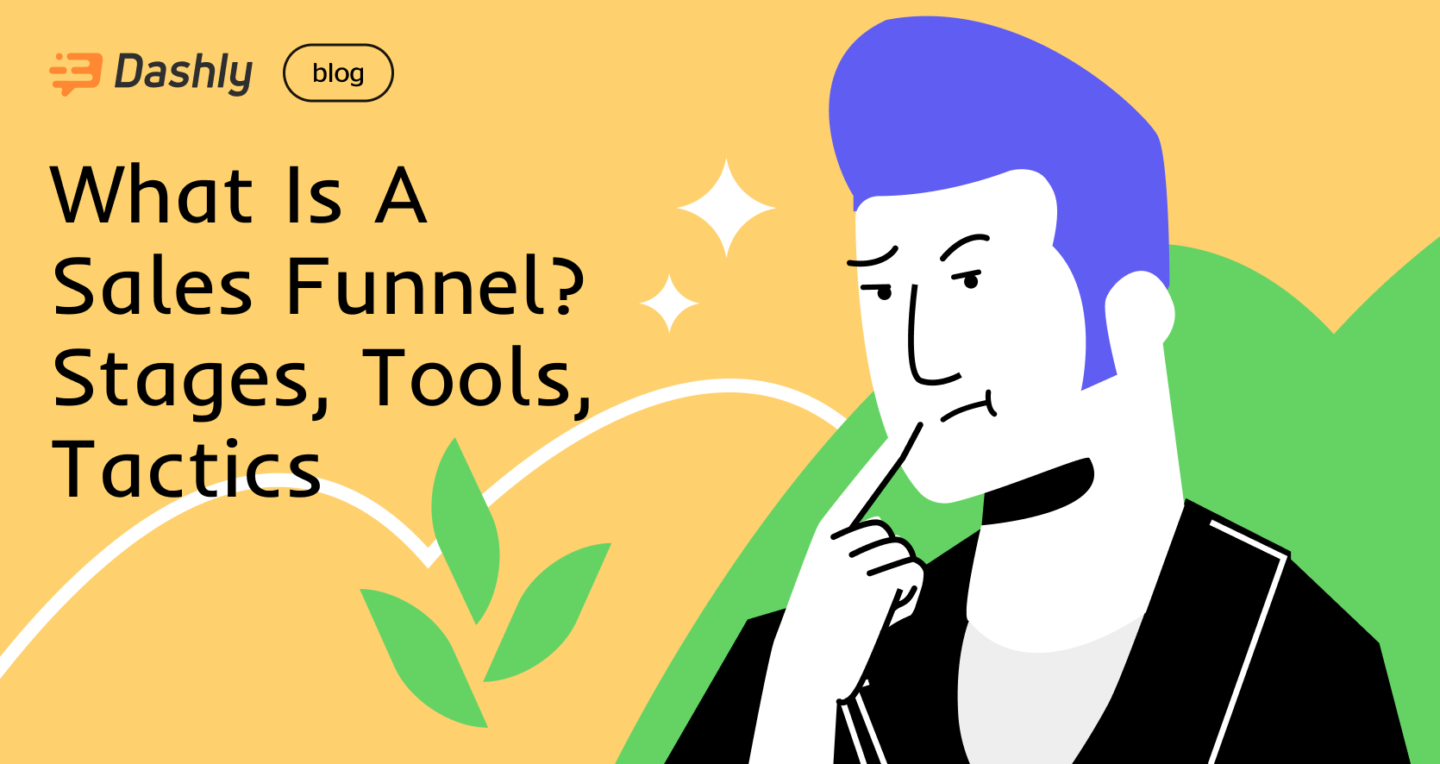
Demo requests falling flat? Frustrating, right? Many companies struggle to fill their inbound funnels with quality leads. The reason? A leaky sales funnel.
In this guide, we’ll break down the sales funnel definition, its stages, and best practices. You’ll learn what is a sales funnel and how does it work in 2025. Plus, discover tools to fix that leaky funnel sales process.
At Dashly, we’ve helped clients double their sales leads. Let me share the steps we’ve seen work. Spoiler: it’s easier than you think. Ready to turn demo requests into wins? Let’s go!
What Is a Sales Funnel? A Simple Explanation
A sales funnel is a visual representation of the customer journey, illustrating the stages a prospect goes through before making a purchase.
Companies implement sales funnels to systematically nurture leads, ensuring no opportunity slips through the cracks. It’s about being proactive, not reactive, in guiding prospects toward a purchase.
In a SaaS B2B context, this typically includes:
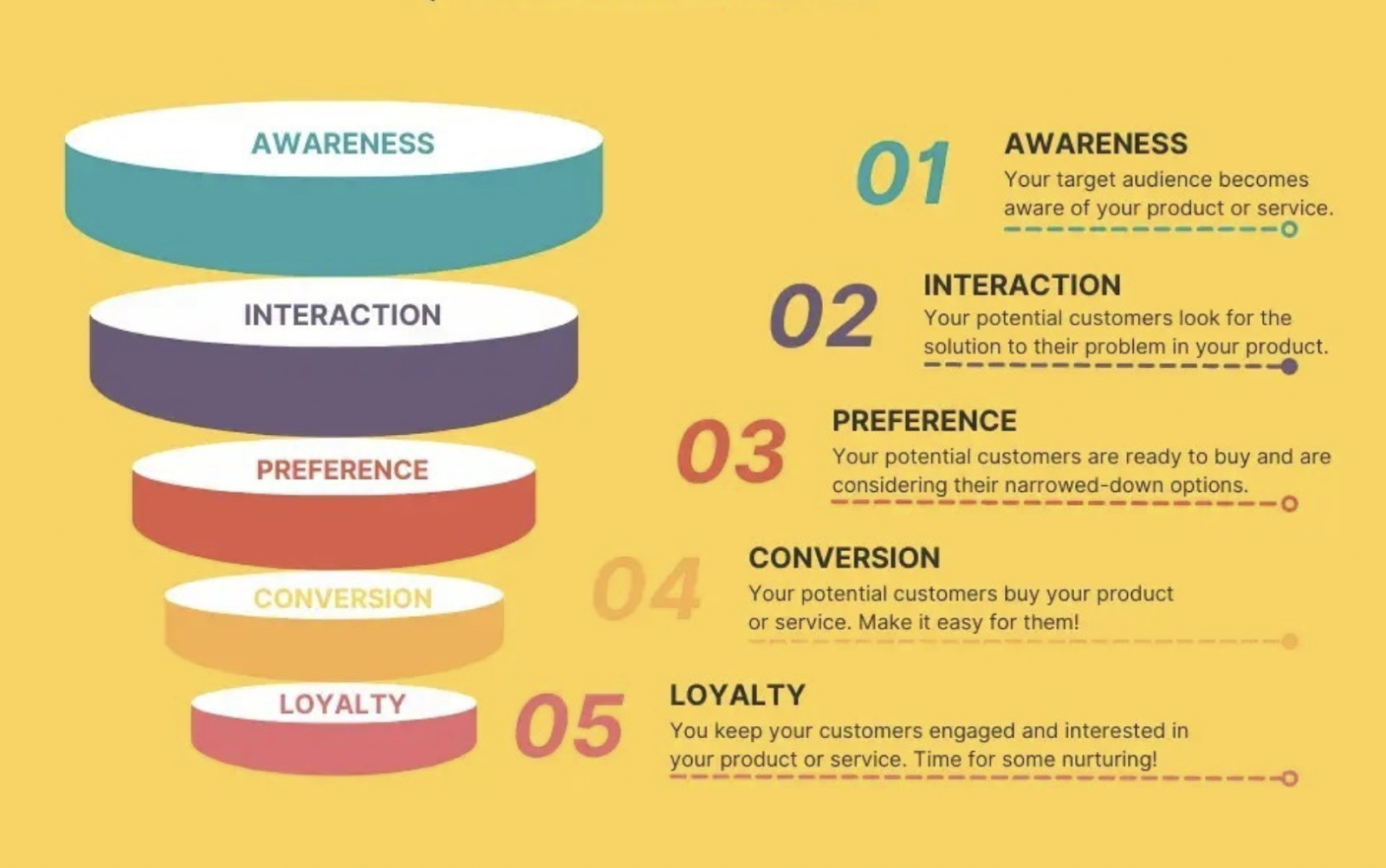
This sales funnel map helps visualize and optimize each step.
Why does this matter? Companies with a well-structured sales funnel see 18 times more revenue growth. Additionally, businesses using sales funnels experience a 102% higher average deal size.
At Dashly, we’ve assisted clients in doubling their sales leads by refining their web sales funnel. By understanding and optimizing each stage, you can guide prospects smoothly from awareness to action. Think of it as a roadmap to revenue.
In today’s competitive landscape, having a clear sales funnel visualization isn’t just beneficial — it’s essential.
Marketing Funnel vs. Sales Funnel: Key Differences
The marketing funnel and sales funnel may look similar, but they serve distinct purposes. Think of them as two gears in the same machine, each essential but designed differently. Let’s break them down by characteristics.
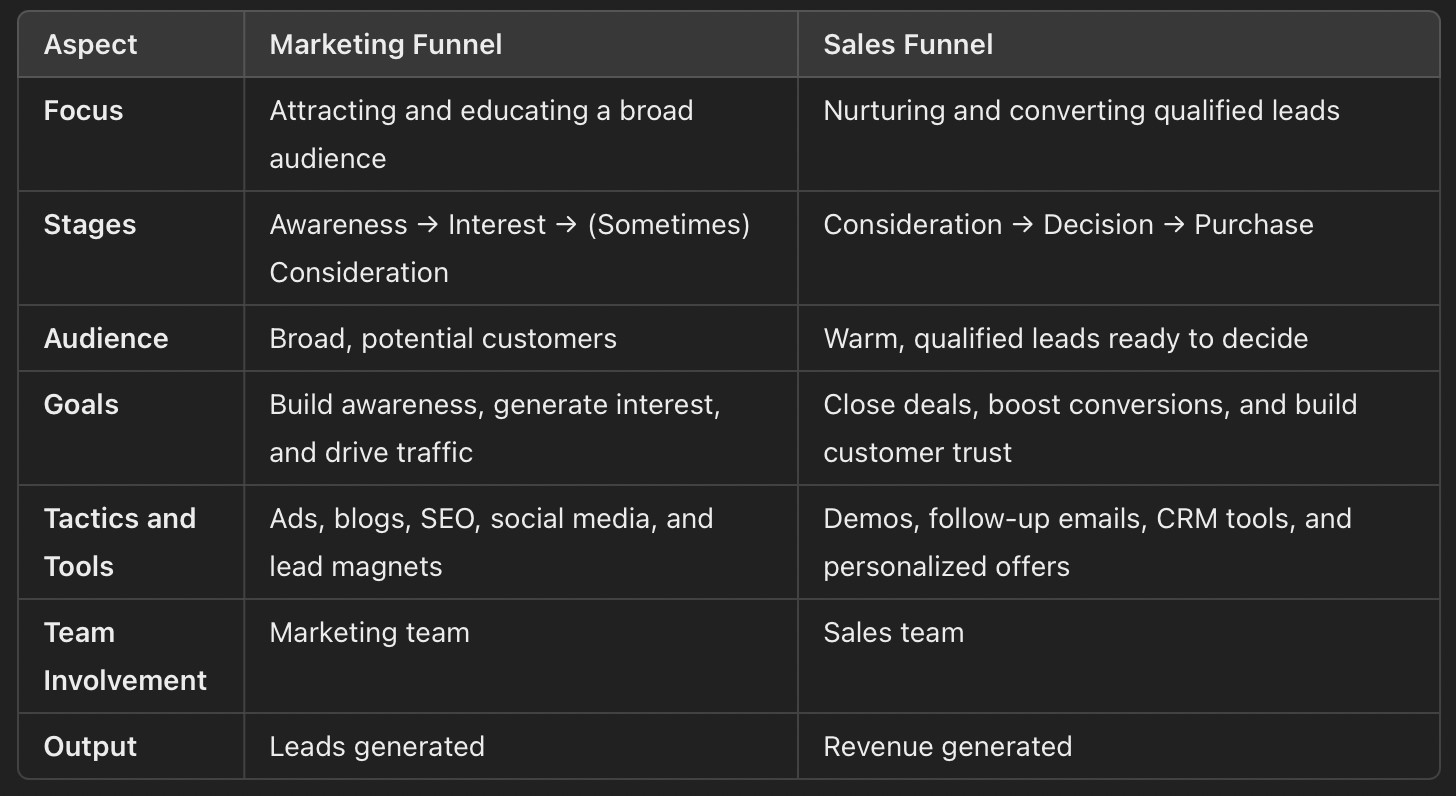
Focus
- Marketing Funnel: Attracts and educates. Its main goal is building awareness and interest. It’s the storyteller, introducing your product to the world.
- Sales Funnel: Converts and nurtures. It focuses on building trust and leading prospects toward making a decision.
Stages
- Marketing Funnel: Includes awareness, interest, and sometimes consideration. It’s about casting a wide net and grabbing attention.
- Sales Funnel: Picks up at consideration and goes through decision to purchase. It narrows the focus, dealing with qualified leads only.
Audience
- Marketing Funnel: Targets a broad audience — those who might be interested in your product but aren’t ready to buy yet.
- Sales Funnel: Engages specific, warm leads. These are people closer to making a purchasing decision.
Tactics and Tools
- Marketing Funnel: Uses ads, blogs, SEO, and social media to drive traffic and generate leads.
- Sales Funnel: Relies on demos, follow-up emails, CRM tools, and personalized offers to close the deal.
Goals
- Marketing Funnel: Build brand awareness and attract as many prospects as possible.
- Sales Funnel: Drive conversions, close deals, and build customer relationships.
Understanding the marketing funnel vs sales funnel differences ensures your teams don’t overlap or drop the ball. Marketing sets the stage; sales seals the deal.
Why Is the Sales Funnel Important for Business Growth?
From my experience at Dashly, I’ve seen one thing over and over: businesses without a clear online marketing sales funnel struggle to scale. Leads slip through the cracks, teams work in silos, and demo requests fall flat. But with the right funnel in place? Growth becomes predictable — and much less painful.
Here’s why every business needs one:

- A sales funnel chart simplifies complex processes. It helps you see where leads are in their journey. No more guessing or losing track.
- A well-structured online marketing sales funnel filters out unqualified leads. It ensures your sales team focuses on prospects likely to convert.
- Knowing the funnel stages allows you to optimize them. Small tweaks in your new sales funnel can make a big difference in turning leads into customers.
- Funnels highlight where leads drop off. This helps fix issues fast, keeping your pipeline healthy and flowing.
- A sales funnel expert knows: alignment matters. Funnels bring marketing and sales teams together to work toward shared goals.
- Funnels streamline follow-ups and sales activities. Automations and tools ensure nothing falls through the cracks.
- With a clear funnel, scaling becomes easier. You can forecast revenue and make data-driven decisions confidently.
A sales funnel chart is more than a tool — it’s a growth engine. Let’s discover how to create it 👇
Sales Funnel Strategy: How to Build One That Works
Every successful sales funnel strategy starts with clear goals and buyer understanding. Here’s how we helped a client double their sales leads using a practical sales funnel model.
Step 1: Map the Funnel Stages
We began by defining the stages of the sales funnel:
- Awareness: Attracting new prospects with targeted content.
- Interest: Engaging leads with tailored messages.
- Consideration: Offering demos or trials to highlight value.
- Decision: Providing clear CTAs to drive action.
Understanding these digital sales funnel stages helped focus efforts where leads were slipping away.
Step 2: Set Up the Funnel
To create a sales funnel that worked, we started with lead magnets to draw attention. Quizzes and pop-ups qualified prospects. Each interaction nudged them closer to conversion.
Clear sales funnel strategies ensured consistency. For example, automation helped follow up without missing a beat.
Step 3: Optimize Every Stage
In the funnel stages in sales, small tweaks made a big difference. Personalizing follow-ups boosted response rates. Clear demo offers at the consideration stage increased meeting requests by 40%.
Tracking data showed where leads got stuck. Continuous tweaks kept the pipeline flowing.
Need to know how to set up a sales funnel for your team? Check out this article for tips. You’ll discover actionable insights to build a sales funnel that works every time.
In case you already have one, here is a list of ideas on how to boost its efficiency 👇
How to optimize a leaky funnel
A leaky sales funnel feels like pouring water into a sieve. Leads come in, but they don’t stick. Sound familiar? At Dashly, we’ve worked with clients who faced the same challenge. Here’s how we helped them fix leaks and double their sales funnel leads:
1. Find the Leaks
Start by analyzing your website sales funnel. Look at the data: where are leads dropping off? Is it during demo sign-ups or follow-ups? A simple audit can reveal gaps. Tools like heatmaps or CRMs can help. For a deeper dive, check out this leaky funnel guide.
2. Tighten Your Messaging
Your funnel’s first impression matters. Unclear CTAs? Confusing landing pages? Fix them. Make every step easy to follow. Highlight the value of booking that demo. Clear messaging plugs more leaks than you think.
3. Improve Lead Nurturing
Not all leads are ready to buy. That’s where nurturing comes in. Use automated emails to guide sales funnel lead generation. Share value-driven content at every stage. A consistent follow-up strategy turns cold leads warm.
4. Optimize Each Funnel Stage
Each stage of your funnel needs attention. From awareness to decision-making, ask: does this step align with my buyer’s needs? For actionable tips, explore our sales funnel optimization strategies.
5. Test, Tweak, Repeat
Optimization isn’t a one-time fix. A/B test CTAs, landing pages, and follow-ups. Regularly revisit your funnel metrics. Small tweaks can bring big results.
A leaky funnel doesn’t just lose leads — it wastes time and money. But with the right fixes, your website sales funnel can thrive. At Dashly, we’ve helped businesses recover lost leads and boost demo requests.
Double your SaaS sales funnel conversion with Dashly AI
⭐ Engage prospects with conversational quiz
⭐ Reach out in their preferrable channel
⭐ Automate lead nurturing with personalized AI sequences
Sales Funnel Examples That Inspire Success
When it comes to sales funnel creation, seeing real-world examples can make all the difference. Let’s dive into three standout cases from our guide that show how the right funnel can transform leads into loyal customers.
Sales funnels are like recipes for growth, but the right ingredients make all the difference. Let’s explore three standout sales funnel creation examples that can elevate your strategy and fill your pipeline with qualified leads.
1. Dashly’s AI-Powered Funnel
Dashly demonstrates how a sales funnel infographic can blend technology with strategy:
- Awareness: SEO and LinkedIn draw organic traffic.
- Lead Qualification: A quiz bot gathers pain points and customizes offers.
- Engagement: AI-powered assistants handle inquiries and book meetings.
- Nurturing: AI-driven emails deliver tailored follow-ups until conversion.
The Dashly way emphasizes the importance of leveraging AI to handle routine tasks, allowing teams to focus on building meaningful relationships with prospects. Incorporate these strategies to optimize your own sales funnel processes and drive growth.
2. HubSpot’s Content-Driven Funnel
HubSpot takes the classic sales funnel to the next level with an inbound focus:
- Awareness: Blogs, webinars, and eBooks address user pain points.
- Lead Capture: Free tools and trials incentivize sign-ups.
- Nurturing: Email sequences guide leads toward their freemium model.
- Conversion: Webinars and tailored offers seal the deal.
Their content-heavy approach shows the power of giving value first.
3. Grammarly’s Freemium Funnel
Grammarly keeps it simple yet effective:
- Awareness: SEO-optimized blogs attract traffic.
- Engagement: A clear value proposition encourages sign-ups.
- Conversion: A freemium model hooks users, while smooth upsells lead to premium subscriptions.
- Retention: Personalized insights and performance reports boost loyalty.
Grammarly’s integrations and freemium plan highlight user convenience as a top priority.
Ready for More Ideas?
These examples prove that no funnel fits all — but each can inspire your inbound sales channels strategy. For more success stories and tips, check out this guide.
Top Tools to Create and Manage Your Sales Funnel
Building a sales pipeline funnel doesn’t have to be overwhelming. From lead capture to follow-ups, the right software can simplify every step. At Dashly, we’ve seen how effective tools not only streamline funnel design but can also double demo requests.
Ready to optimize your business? Let’s explore the top software for seamless sales funnel creation.
Dashly
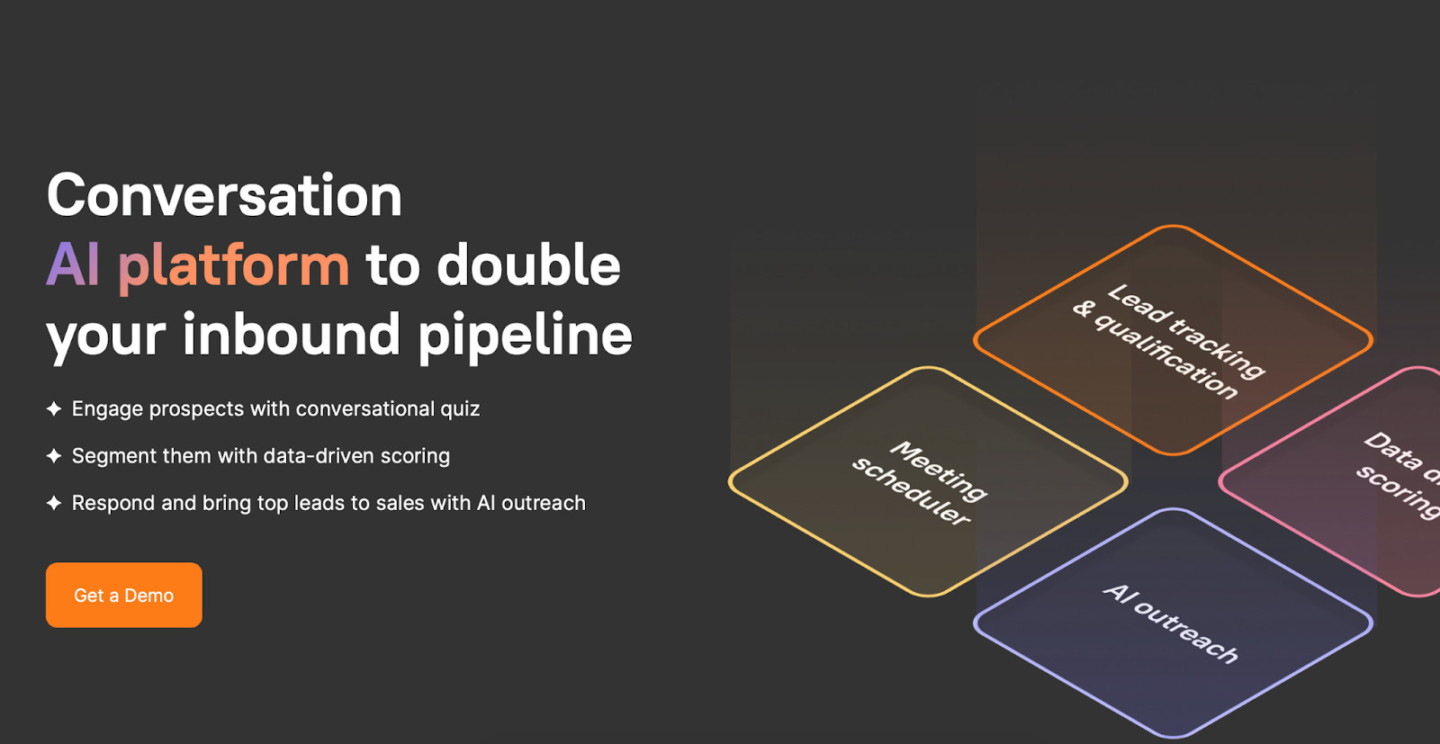
Dashly is a conversation-driven AI platform crafted to optimize the sales conversion funnel and double your inbound pipeline — without increasing costs. Its robust features, including conversational qualification, AI outreach, and data-driven scoring, make it the go-to choice for product startups and mid-size SaaS companies aiming to streamline their digital sales funnel.
Trusted by forward-thinking teams, Dashly allows businesses to qualify leads, prioritize them, and move them efficiently through the top of funnel sales to conversion.

Sales Funnel Tools
Dashly’s key sales funnel tools include:
- Conversational Qualification. Engage prospects in interactive conversations to gather qualification data. This feature boosts lead qualification rates by up to 80%, delivering 1.5x more quality leads to the lead generation sales funnel.
- Data-Driven Scoring: Automatically segments leads into ready-made ABC categories based on conversion potential, saving time and removing manual lead qualification.
- AI Outreach. Dashly’s AI-powered SDR nurtures and guides leads automatically up to the meeting, ensuring a seamless journey through the sales pipeline funnel.
Pricing
Dashly offers flexible, on-demand pricing, ensuring that you only pay for the features you need based on your website traffic. This model is ideal for scaling businesses that require adaptability as they grow.
Pros and Cons
Pros
- High Lead Qualification: The conversational quiz helps achieve high engagement and qualification rates, leading to more quality leads.
- Comprehensive Features: Combines live chat, chatbots, automated outreach, and detailed lead scoring in one platform.
- Flexible Pricing: On-demand pricing adapts to your traffic and growth, making it cost-effective.
Cons
- Learning Curve: The wide range of features may require time to master.
- Higher Costs with Increased Traffic: While pricing is flexible, high traffic volumes can lead to increased costs.
Dashly is a leading choice for businesses seeking a scalable, AI-powered platform for building a sales funnel and guiding leads seamlessly to conversion.
Double your SaaS sales funnel conversion with Dashly AI
⭐ Engage prospects with conversational quiz
⭐ Reach out in their preferrable channel
⭐ Automate lead nurturing with personalized AI sequences
GetResponse
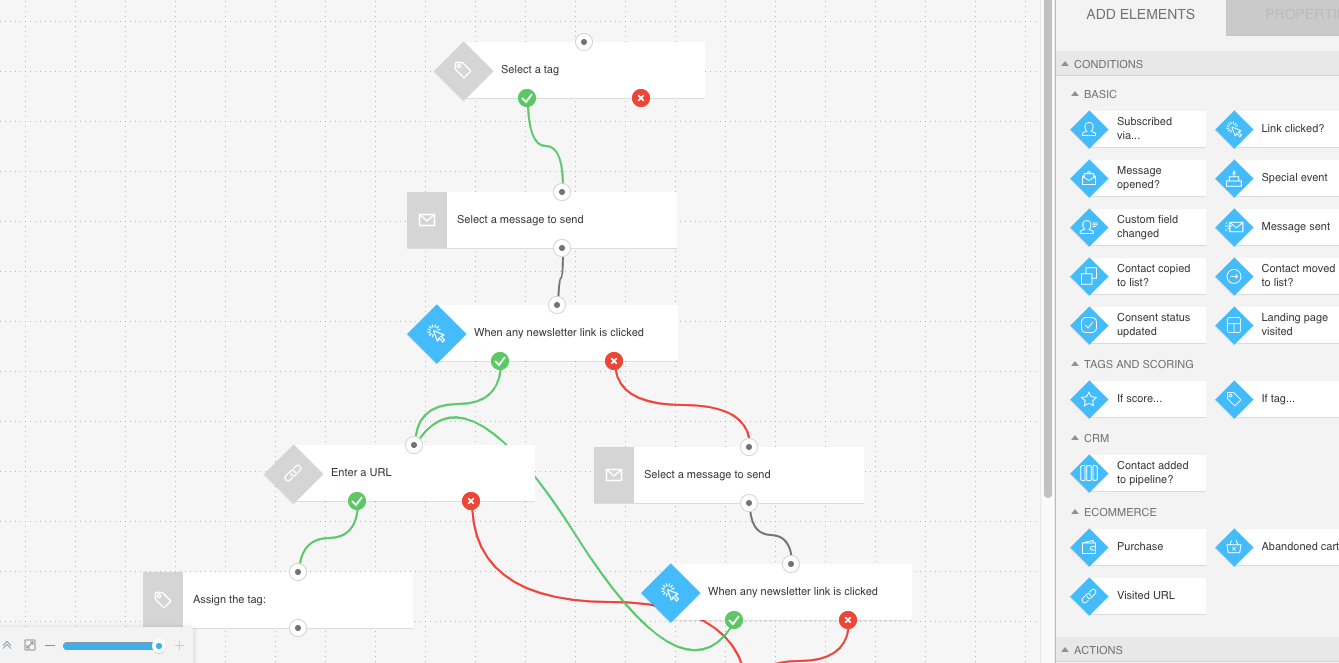
GetResponse has been a trusted player in the sales funnel software market for over 20 years. Its all-in-one platform supports sales funnel design, lead generation sales funnels, and evergreen sales funnel setups, making it a favorite among SaaS startups and mid-sized companies.
Features
- Email Automation: Automate nurturing emails for each stage of the sales funnel online, freeing up team resources.
- Landing Page Builder: Drag-and-drop templates simplify lead capture directly within the sales lead funnel.
- Webinars: Host live or evergreen webinars to build trust and engage potential customers.
- CRM Integration: Basic CRM features for managing, tagging, and tracking leads in the business sales funnel.
- Sales Funnel Templates: Pre-designed templates help jumpstart your sales pipeline funnel with ease.
- Analytics & Reporting: Real-time data insights to refine the sales funnel design and optimize results.
Pricing
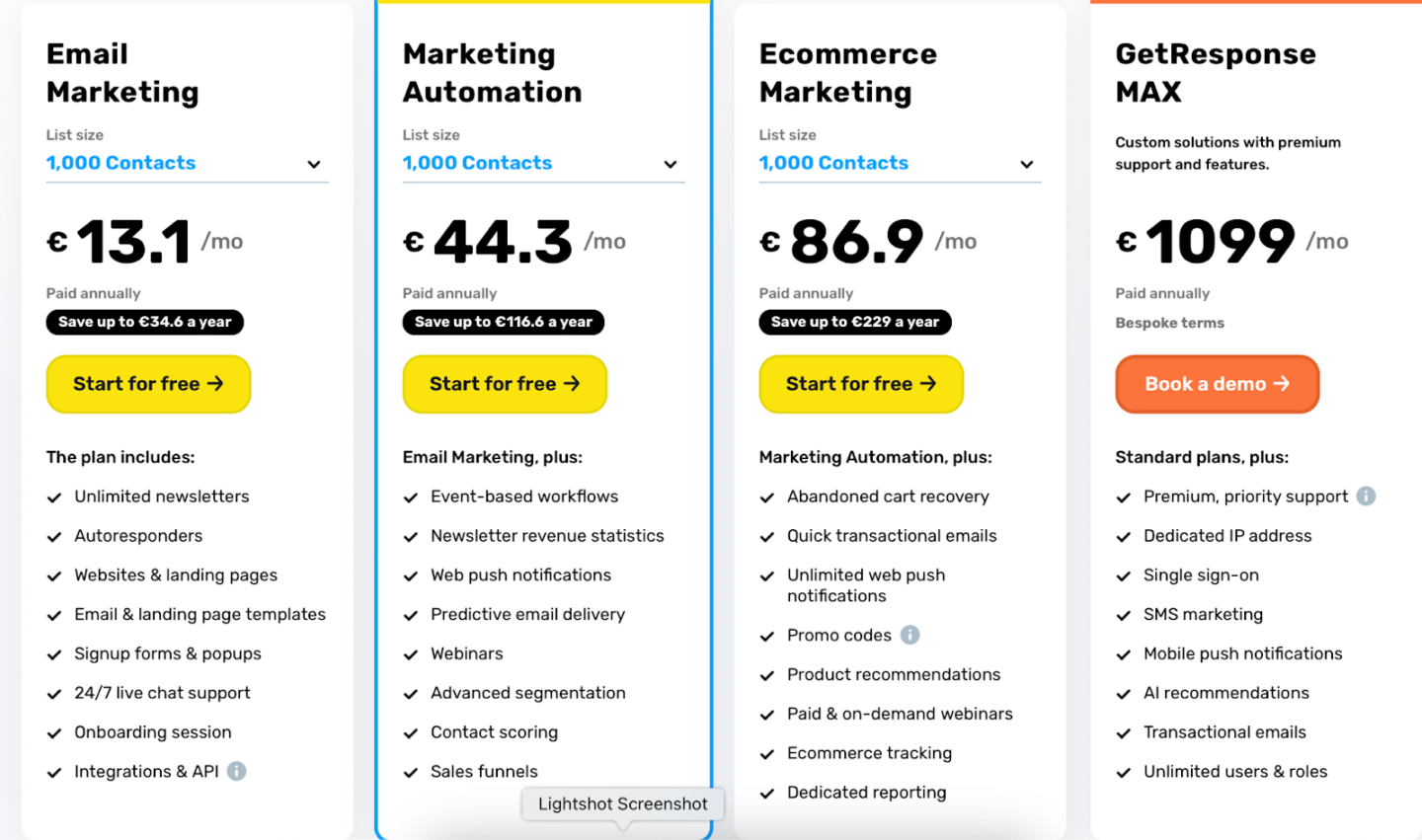
- Email Marketing: Starts at $19/month, ideal for newsletters and list building.
- Marketing Automation: From $59/month, includes workflows and advanced segmentation.
- Ecommerce Marketing: $119/month for e-commerce tools like abandoned cart recovery.
- GetResponse MAX: Custom pricing for enterprise-level support, SMS marketing, and multi user access.
Pros
- Comprehensive features for multi-channel marketing.
- Affordable plans with extensive tools for creating a sales funnel.
- Reliable customer support.
Cons
- Limited segmentation options for advanced targeting.
- No permanent free tier for smaller businesses.
GetResponse simplifies sales funnel creation with tools that combine automation, lead tracking, and engagement, making it ideal for businesses needing an all-in-one solution.
Systeme.io

Systeme.io is an affordable, beginner-friendly platform for building a sales pipeline or funnel. Designed for product startups and mid-sized SaaS companies, it integrates email marketing, e-commerce, and sales funnel design into one system.
Features
- Funnel Builder: Create, customize, and launch sales funnels with templates for every stage — perfect for guiding leads from awareness to conversion.
- Email Automation: Set up email campaigns with autoresponders and conditional workflows to nurture and engage leads throughout the sales funnel.
- Membership Sites: Easily build and manage membership sites to deliver gated content, online courses, and other subscription-based offerings.
- A/B Testing: Test different funnel elements like landing pages or emails to optimize conversions based on real performance data.
- E-commerce Integration: Sell both digital and physical products within the same system; includes checkout pages, upsells, and payment processing.
- Webinars and Blogging: Run evergreen or live webinars, and maintain a blog to attract traffic and engage your audience — all within the same tool.
Pricing
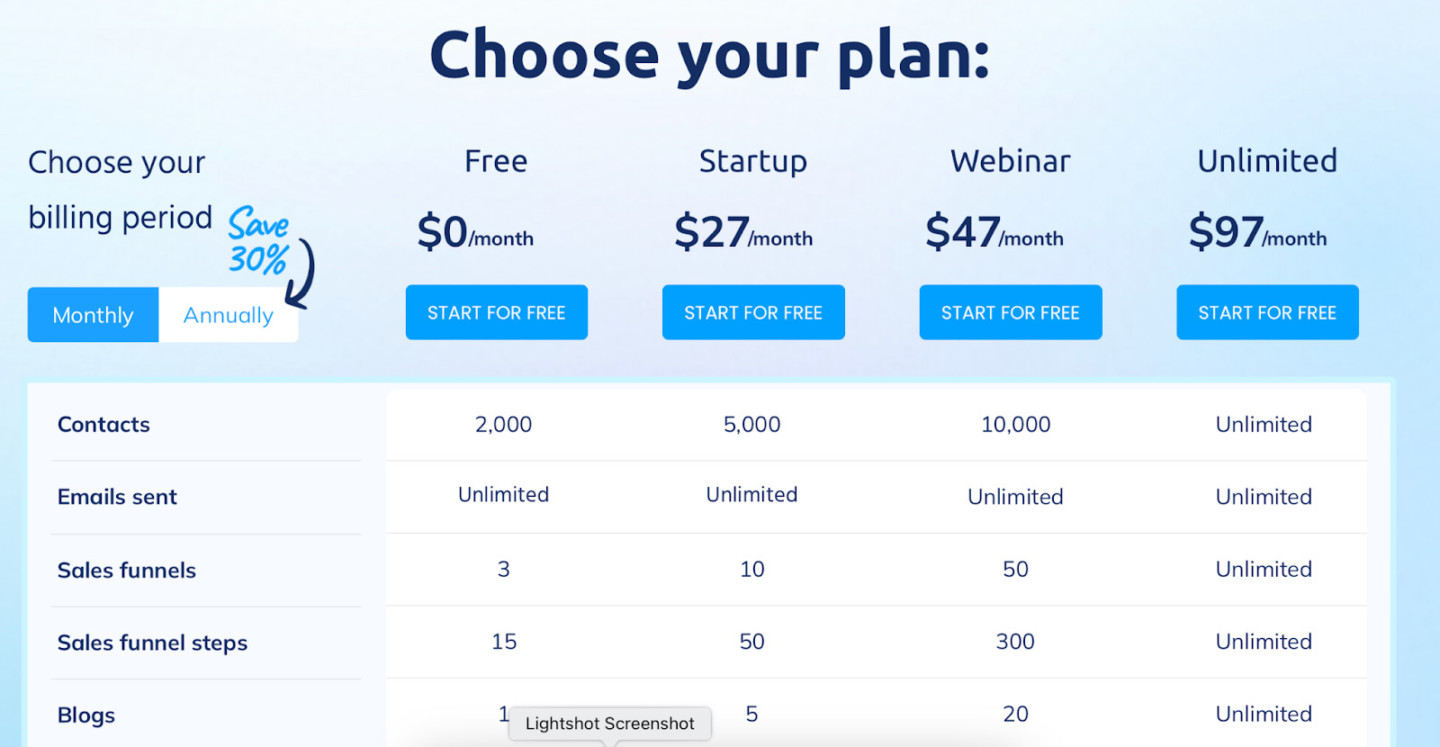
Systeme.io offers accessible pricing plans to cater to businesses of all sizes:
- Free: $0/month — Basic features including essential tools for starting out.
- Startup: $27/month — Ideal for small businesses, offering advanced tools and more capacity.
- Webinar: $47/month — Adds webinar capabilities for engaging audiences.
- Unlimited: $97/month — Full access with unlimited tools, automation, and capabilities for growing enterprises.
Pros
- Affordable, all-in-one solution for sales funnel creation.
- Intuitive templates and design tools for easy setup.
- Strong customer support.
Cons
- Some users desire more detailed customization in design features.
- Occasional email delivery issues and a lack of immediate phone support.
- The free plan is limited to three funnels and lacks some advanced features.
Systeme.io excels in providing cost-effective tools for digital businesses looking to streamline their sales pipeline funnel.
Find 12 more tools in the article:

TOP 15 best sales funnel software to grow the number of deals closed
Sales Funnel Analysis: Metrics to Track and Improve
Analyzing your simple sales funnel isn’t just smart—it’s essential. Without tracking the right metrics, you’re guessing instead of growing. At Dashly, we’ve helped businesses fine-tune their pipeline and double demo requests using proven strategies. Ready to optimize? Here’s what to measure and why.
1. Customer Lifetime Value (CLV)
This metric shows the total revenue a customer will bring to your business over their lifetime.
Formula: Average purchase value * Number of purchases per year * Customer lifespan
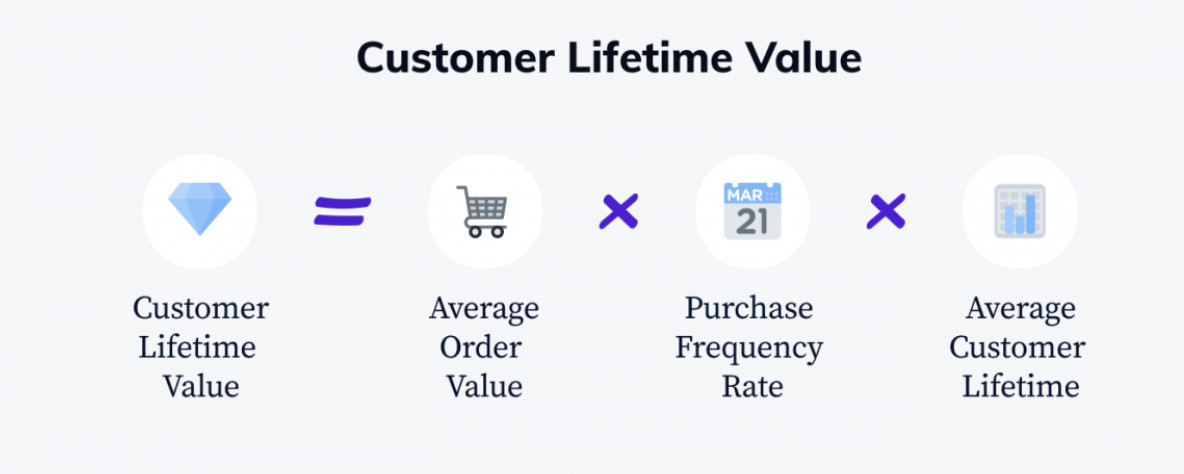
If a customer spends $1,000 yearly and stays with you for 3 years, their CLV is $3,000. One client found that focusing on upselling additional services increased their CLV by 20%.
How to improve ➡️ Upsell more to existing customers. Keep them engaged with new features, premium plans, or additional services.
2. Drop-off Rate
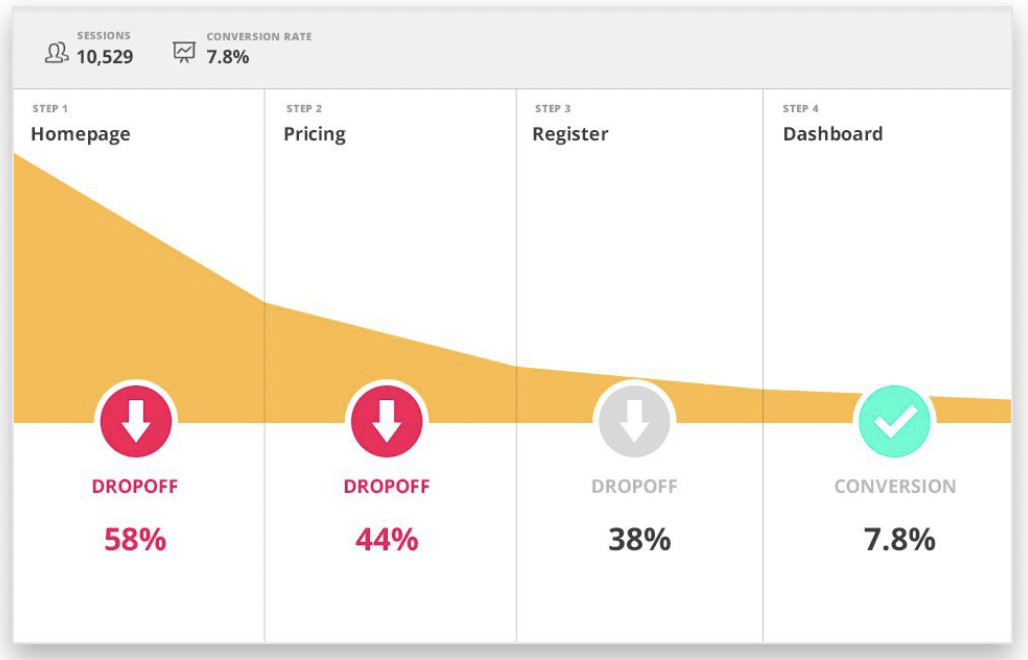
Where are your leads bailing? Is it during sign-ups, demo scheduling, or pricing discussions? A leaky sales funnel graph wastes time and money. Identify pain points at each stage and build a sales funnel that addresses friction. Use an automated system to track behavior and optimize touchpoints dynamically for better retention.
3. Average Deal Size
How much revenue does each conversion bring? For SaaS companies scaling their sales funnel pipeline, this metric is critical. Analyzing it helps uncover upsell opportunities, identify valuable customer segments, or adjust pricing models. A well-planned strategy includes tracking revenue trends to ensure consistent growth.
4. MQL to SQL Conversion Rate
This metric shows how many marketing-qualified leads (MQLs) turn into sales-qualified leads (SQLs). It’s a huge indicator of how well your marketing efforts are working.
Formula: (SQLs / MQLs) * 100
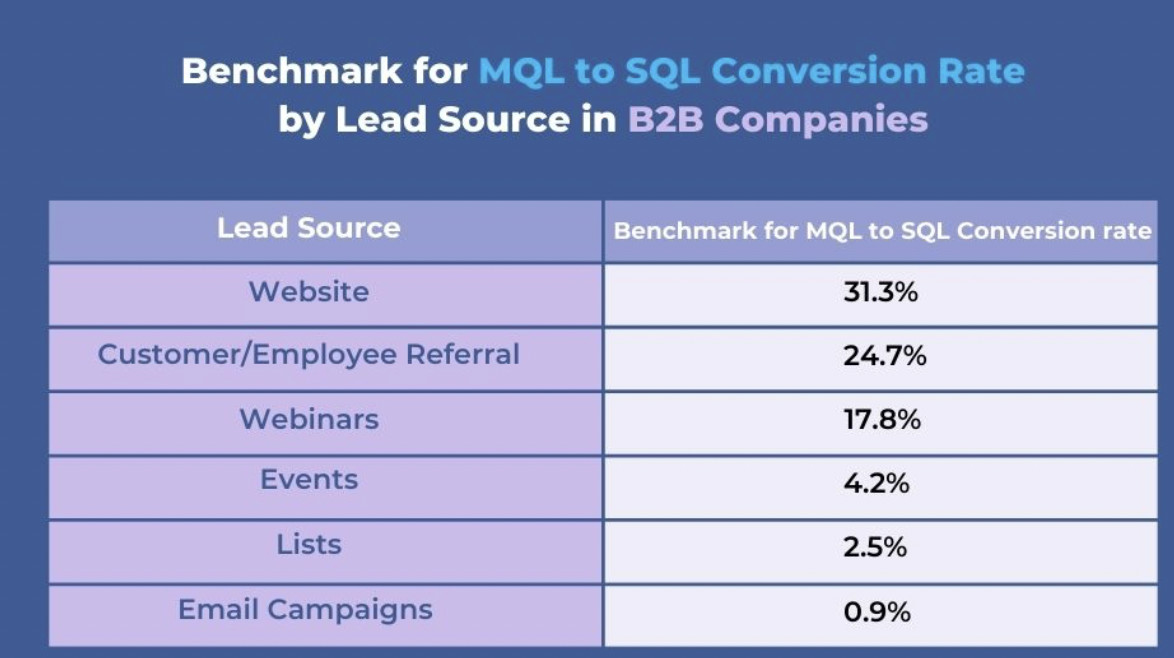
Let’s say you generated 500 MQLs, and 150 became SQLs. Your MQL to SQL conversion rate would be 30%. For one SaaS company, we found that tweaking their lead-nurturing emails boosted this number by 20% in just a month.
How to improve ➡️ Optimize your lead-nurturing emails with relevant, personalized content that speaks directly to each lead’s pain points. AI tools can help create these faster.
5. Customer Acquisition Cost (CAC)
Is your funnel cost-effective? Compare your CAC with your Lifetime Value (LTV) to ensure sustainable growth. A high CAC often signals inefficiencies in your sales funnel strategy. Use funnel graphs to pinpoint expensive stages, then adjust your targeting or messaging to balance acquisition costs. For ABM sales funnels, focus on the ROI of specific account campaigns.
Find more ideas on how to track your funnel performance with these two articles
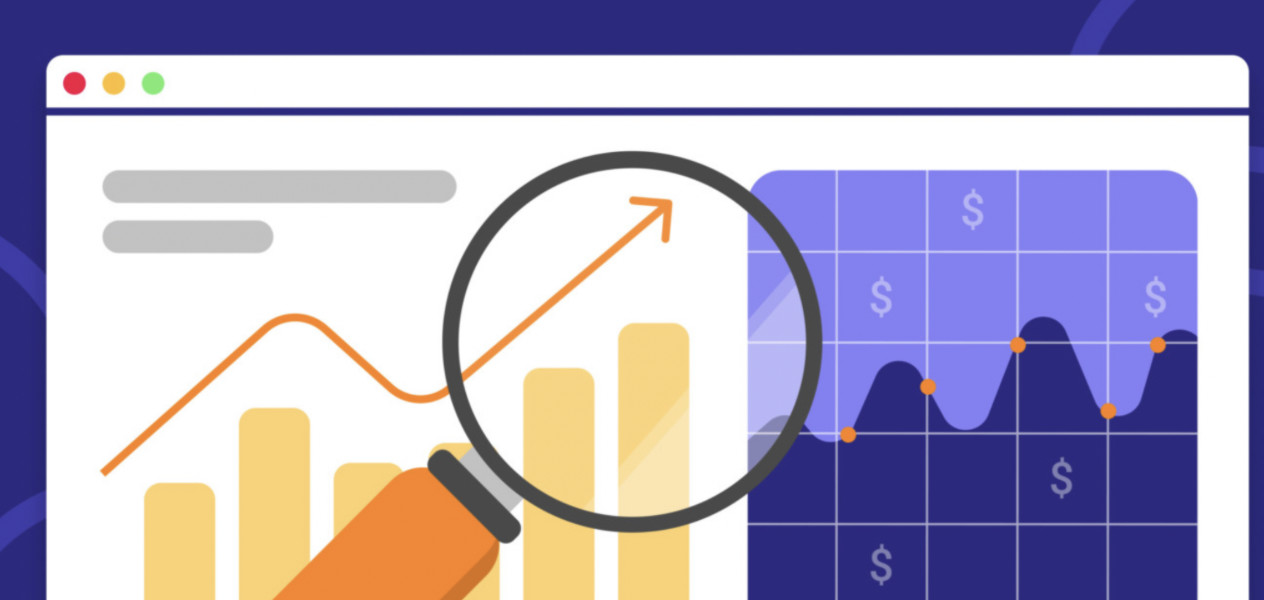
16 Essential Sales Funnel Metrics You’re Probably Not Tracking (But Should Be)
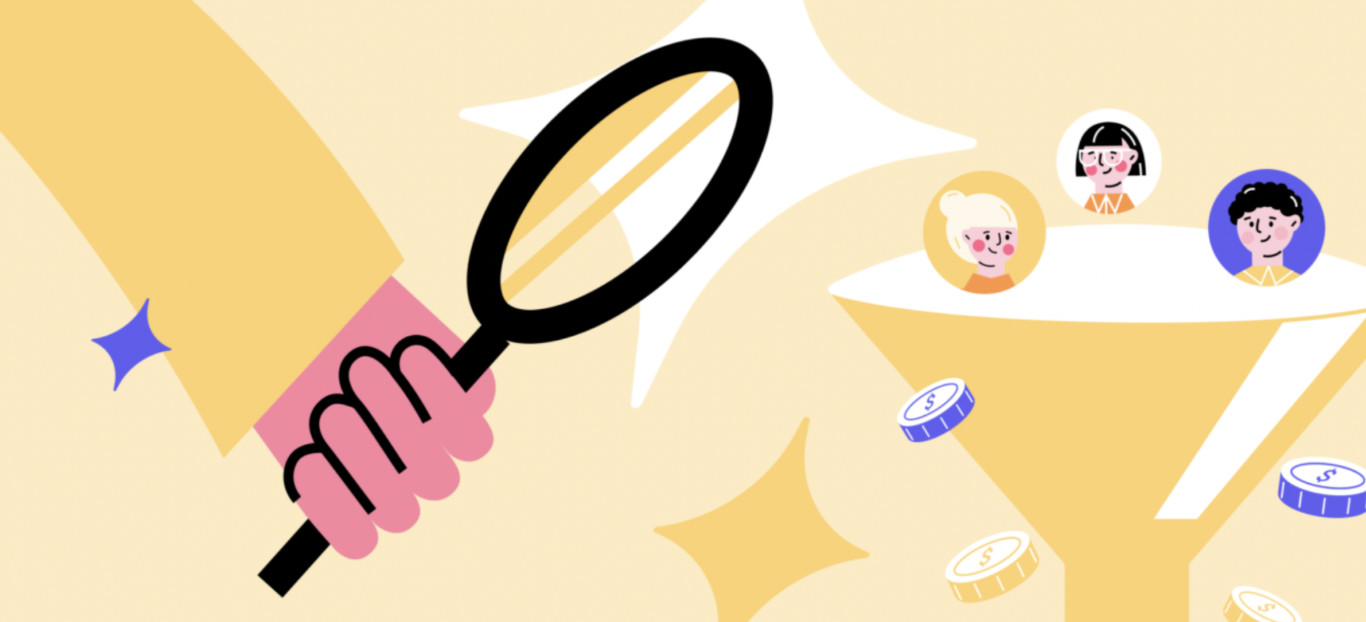
Mastering sales funnel analysis: step-by-step guide, tools, and examples
How Dashly Automates and Enhances Sales Funnels
Struggling to fill your calendar with demo requests? Dashly’s here to fix that. We’re not about adding fluff to your funnel — we’re about delivering results.
Here’s the deal:
- First, we qualify your leads. Our smart quiz bot talks to your site visitors, asks the right questions, and identifies who’s ready to take the next step. No more wasting time on “just browsing” prospects.
- Then, we make scheduling demos effortless. Dashly’s AI assistant works like your best SDR. It chats with leads, answers their questions, and books a meeting in your team’s calendar — all while you focus on closing deals.
- And we don’t stop there. Once the demo is booked, Dashly keeps leads warm and engaged with personalized email sequences. These aren’t your generic “Hey, just checking in” emails. They’re tailored to each prospect’s needs, keeping them excited about what you offer until the big day.
Ready to Optimize?
Want better metrics and fewer leaks? Let’s make it happen. Schedule a demo with Dashly, and we’ll help you turn your lead sales funnel into a conversion powerhouse.
Sales Funnel FAQ: Your Questions Answered
A sales funnel meaning is about the journey your potential customers take from discovering your business to making a purchase. It’s typically broken into stages like awareness, interest, consideration, and decision. A well-designed funnel guides seamlessly through each stage, increasing the chances of conversion.
In digital marketing, a sales funnel involves online strategies to guide potential customers. From SEO and social media to email follow-ups, it leverages digital touchpoints to engage and convert prospects. Tools like chatbots and personalized emails play a key role in optimizing this process.
A sales funnel is about the buyer’s journey, showing how prospects move through stages until they convert. A sales pipeline, on the other hand, tracks the sales team’s actions, like calls made or deals in progress. The funnel is customer-focused, while the pipeline is team-focused.
Start with simple tools like Google Sheets to map out your funnel stages or use ready made templates.
Read also: Ultimate guide to an AI sales funnel: the best tips, tools and common mistakes to avoid


